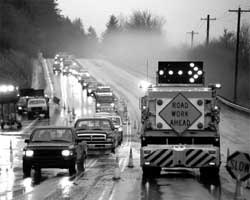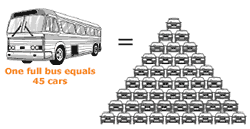Fact Sheet 4 - Delaware’s Survival Plan for the I-95 Shutdown
July 2000
The Delaware Department of Transportation (DelDOT) is in the midst of a major reconstruction project on a heavily traveled section of I-95. Extensive planning by DelDOT, along with widespread community involvement, went into making sure that construction disruptions are kept to a minimum. A year-long information campaign alerted the public about alternate ways to get around the northern Delaware section of I-95, which closed in March for the construction.
Why Reconstruction Is Needed
 I-95
is a vital transportation link for the entire corridor from Maine to
Florida. According to DelDOT officials, the roadbed is almost 30 years
old and needs serious safety improvements and repairs. Seventy percent
of the joints in the sections that will be replaced have failed or need
repair, and on ramps and bridges need structural or safety improvements.
The past mild winters have helped keep the roadbed intact, but DelDOT
officials said that one severe winter could cause extensive damage.
I-95
is a vital transportation link for the entire corridor from Maine to
Florida. According to DelDOT officials, the roadbed is almost 30 years
old and needs serious safety improvements and repairs. Seventy percent
of the joints in the sections that will be replaced have failed or need
repair, and on ramps and bridges need structural or safety improvements.
The past mild winters have helped keep the roadbed intact, but DelDOT
officials said that one severe winter could cause extensive damage.
The project is not just a resurfacing but includes reconstruction of the underlying roadbed, safety upgrades, major bridge rehabilitation, and drainage improvements.
The two-phase project includes the northern Delaware section of I-95 from the Pennsylvania line to just above Route 202. Work is currently underway on the southbound lanes, and when those are completed and opened, the northbound side will follow. In 2002, reconstruction will shift to the Wilmington section of I-95.
Citizens Group
The I-95 North Working Group, a citizen advisory panel, reviewed several alternatives and recommended using the shortest reasonable construction period. The Working Group considered alternatives that would maintain traffic during construction but concluded that these approaches would slow work on bridges. Closing all lanes on the side being rebuilt was the fastest and the least expensive option chosen by the group to meet the construction objectives.
 Children can enjoy learning about highway safety while doing the activities in this coloring book. |
Public Information Campaign
Before and during reconstruction DelDOT implemented a multi-tiered plan to improve traffic mobility. The first element was to create public awareness of the project. An aggressive public information campaign included creation of a graphic theme and an animated character called the “Traffic Creep.” Newspaper ads, radio advertising, and transit advertising got information out about the I-95 closing. The advertising theme centered on the slogan “Beat the Creep.” Additionally, a Survival Guide was published to explain what was happening, when it would happen, and what to do to plan ahead.
Traffic Management Improvements
To improve the flow of traffic, DelDOT implemented an Integrated Transportation Management System for reducing congestion. I-95 Geometric Improvements Maps were developed and distributed to the public. Also, real-time camera images of selected major roadways are broadcast on the web at http://www.deldot.net to allow motorists to plan their route.
Traveling Together
 One
DelDOT goal was to get as many cars as possible off I-95. Part of the
effort to fight congestion was to encourage motorists to carpool or
use public transit. According to DelDOT, one full bus takes 45 cars
off the road.
One
DelDOT goal was to get as many cars as possible off I-95. Part of the
effort to fight congestion was to encourage motorists to carpool or
use public transit. According to DelDOT, one full bus takes 45 cars
off the road.
In addition to the existing service, DART First State, an operating division of DelDOT, added 2 new “Expresso” routes that operated from select park and rides. The “Expresso” routes offered passengers a free coffee coupon that could be redeemed in the downtown business district. Also, 3 new SEPTA R2 commuter rail trips were added providing service between Newark, Delaware and Philadelphia, Pennsylvania. With the greatest increase in ridership being on the rail service, passengers enjoyed the convenience of rail and express bus service to avoid traffic congestion due to construction.
To learn more, contact:
Mike Hitchens
Chief Safety Officer
Delaware Department of Transportation
250 Bear Christiana Road
Bear, DE 19701
Phone: 302-323-5325
E-mail: mhitchens@mail.dot.state.de.us
Matthew Hake
Construction & Material Engineer
Federal Highway Administration
300 South New Street, Room 2101
Dover, DE 19904
Phone: 302-734-1657
E-mail: matthew.hake@fhwa.dot.gov
To share your Best Practices, contact:
Phillip Ditzler
Federal Highway Administration
400 Seventh Street, S.W.
Washington, DC 20590
Phone: 202-366-0855
Email: Phillip.Ditzler@fhwa.dot.gov
U.S. Department of Transportation
Federal Highway Administration
Publication No. FHWA-OP-00-025
